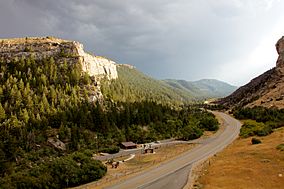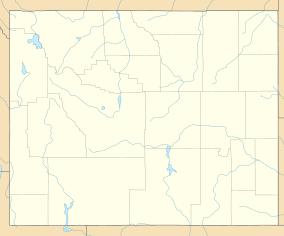Sinks Canyon State Park facts for kids
Quick facts for kids Sinks Canyon State Park |
|
|---|---|
|
IUCN Category III (Natural Monument)
|
|

Sinks Canyon State Park, looking west from the entrance of the canyon
|
|
| Location | Fremont County, Wyoming, United States |
| Nearest city | Lander, Wyoming |
| Area | 600 acres (240 ha) |
| Elevation | 6,122 ft (1,866 m) |
| Designation | Wyoming state park |
| Established | 1971 |
| Administrator | Wyoming State Parks, Historic Sites & Trails |
| Website | Sinks Canyon State Park |
Sinks Canyon State Park is a cool outdoor area in the Wind River Range in Wyoming. It's about 6 miles southwest of Lander, Wyoming. This park is special because of a unique river trick!
The park gets its name from the Middle Fork Popo Agie River. This river flows right into a huge underground cave, which people call "the Sinks." Then, about a quarter-mile away, the water magically reappears from a pool called "the Rise." It's like the river disappears and then comes back to life! The park is looked after by the Wyoming Division of State Parks and Historic Sites.
Contents
Exploring Sinks Canyon's Past
People have been using Sinks Canyon for thousands of years. Scientists have found old fire pits and tools from as far back as the last ice age. For a long time, the canyon and its river have been important for different things.
How Sinks Canyon Became a Park
The state of Wyoming bought large parts of the canyon in 1939 and 1953. They wanted to protect the wildlife and the fish in the river. In 1963, a company gave the "Rise" area and seven acres around it to the city of Lander.
In 1970, city and state leaders worked together to create Sinks Canyon State Park. It was the very first park made under the new Wyoming Recreation Commission. The law to create the park was signed in 1971. A new viewing spot was built at the Rise in 1972, and the visitor center opened in 1973.
Nature's Wonders in Sinks Canyon
Sinks Canyon is full of amazing natural features. From its unique geology to its diverse plant and animal life, there's a lot to discover.
The Canyon's Rocks and Rivers
The canyon was shaped by huge sheets of ice moving long ago. This created deep cracks and steep cliff walls in the Madison Limestone Formation. As the ice melted, it left behind piles of rock and dirt on the canyon floor. Sinks Canyon is one of many canyons on the eastern side of the Wind River Range.
The Mystery of the Rise
No one knows the exact path the river takes underground from the Sinks to the Rise. Scientists have put dye in the water, and it takes over two hours for the water to travel just a quarter-mile! Also, more water comes out of the Rise than goes into the Sinks. The local Crow Indian name for the river, "Popo Agie," means "gurgling river."
Plants and Trees of the Canyon
Sinks Canyon has many different kinds of plants. What grows there depends on how high up you are and where you are in the canyon. You'll find lots of grasses, trees, and bushes. The canyon has two main types of environments: a dry area with lots of sagebrush, and a forest area with pine and fir trees.
Most of the trees in the canyon grow on the south-facing wall. Common trees include aspen, subalpine fir, Douglas fir, lodgepole pine, Engelmann spruce, and whitebark pine. Some of these trees are very old. Studies of tree rings have found Douglas fir trees that started growing as early as 1649!
Animals Living in Sinks Canyon
The canyon is home to many different animals. You might see prairie rattlesnakes, bull snakes, mule deer, and yellow-bellied marmots. About 94 different kinds of birds have been seen here, including amazing golden eagles and prairie falcons.
Sinks Canyon Weather
The weather in Sinks Canyon is like the surrounding area. Summers are warm and dry, while winters are cold with snow. Summer temperatures can get above 90 degrees Fahrenheit. Winters can be cold or mild, depending on which side of the canyon you are on. Most of the rain and snow falls in spring and fall. The deepest snow usually piles up on the north-facing side of the canyon.
Fun Things to Do in Sinks Canyon
Sinks Canyon State Park offers lots of fun activities for visitors.
There's a visitor center at the Sinks where you can learn more. You can also stand on an observation deck to watch the water at the Rise. The park has great hiking trails for exploring. You can also go camping, have picnics, try rock climbing, and go fishing. Above the canyon, there are lakes and other areas like Worthen Meadow Reservoir where you can find more trails and camping spots.
Images for kids












